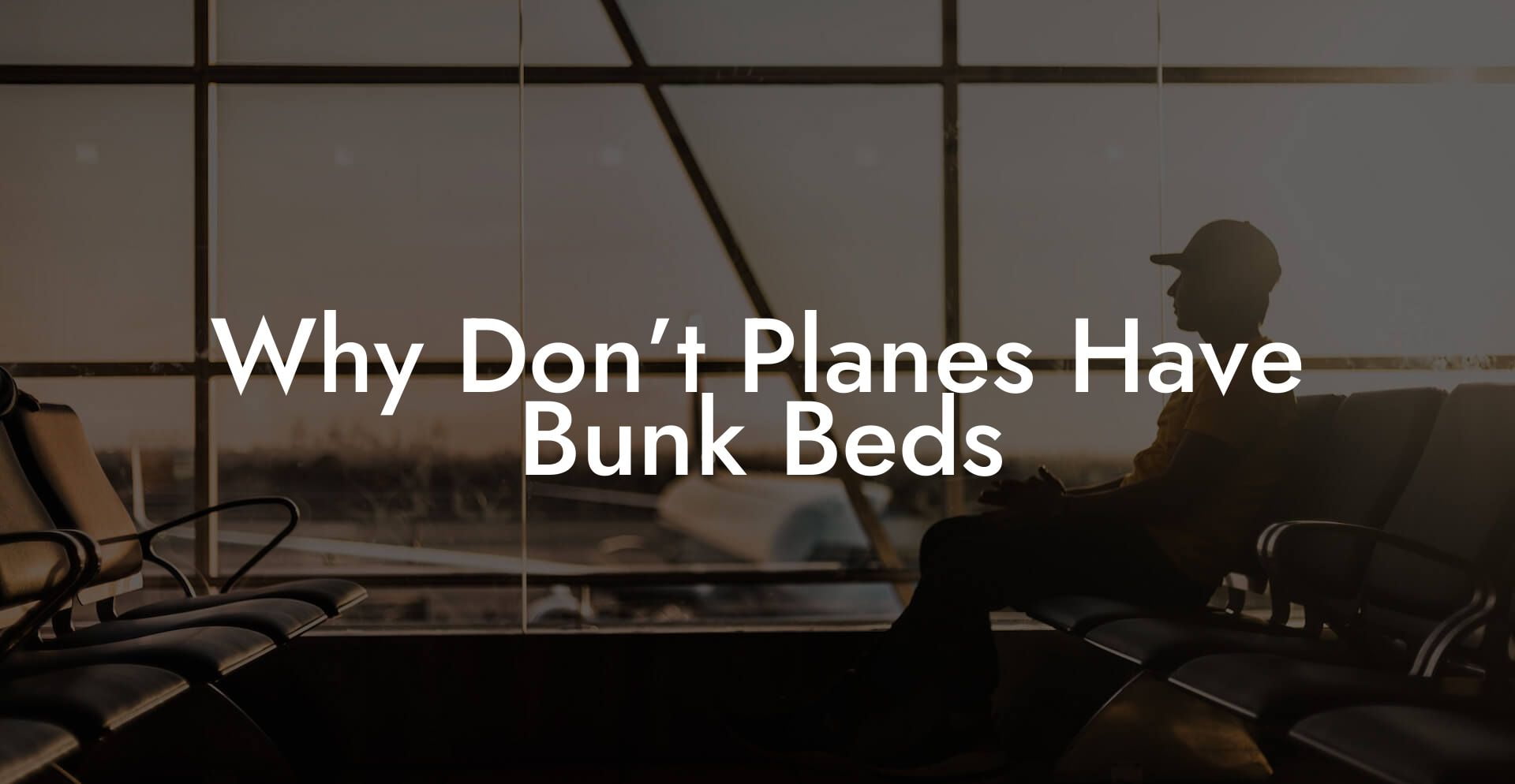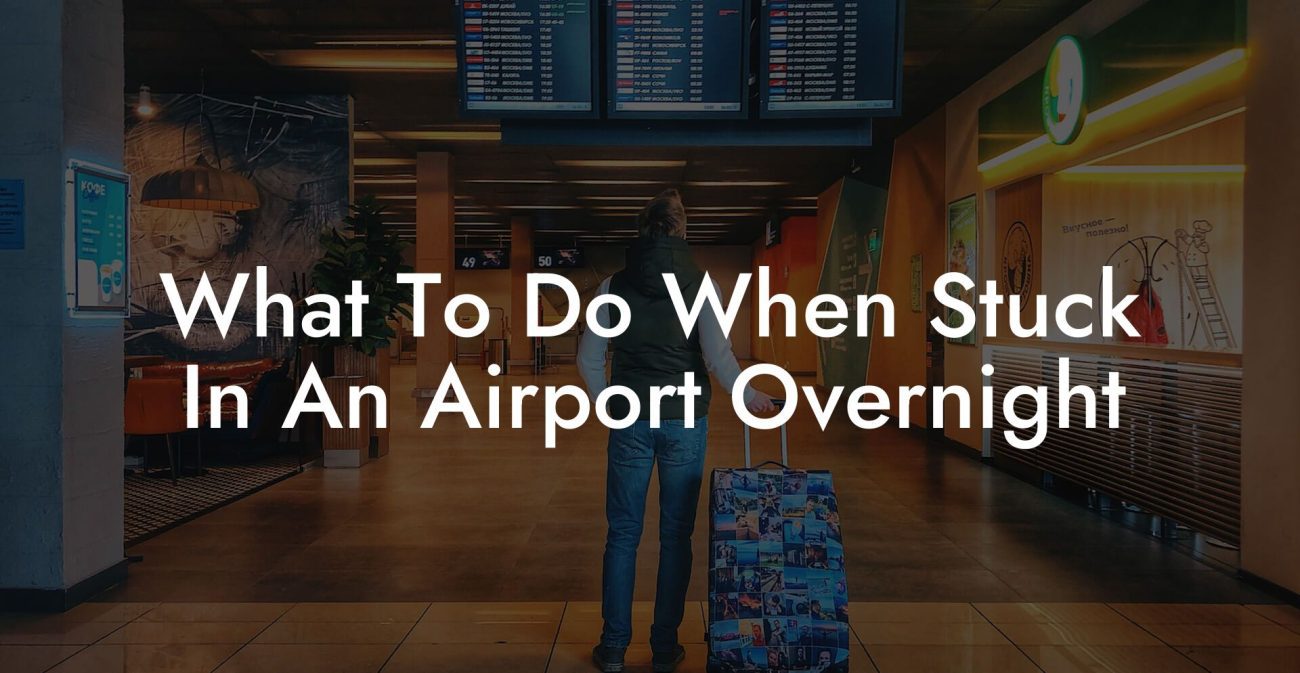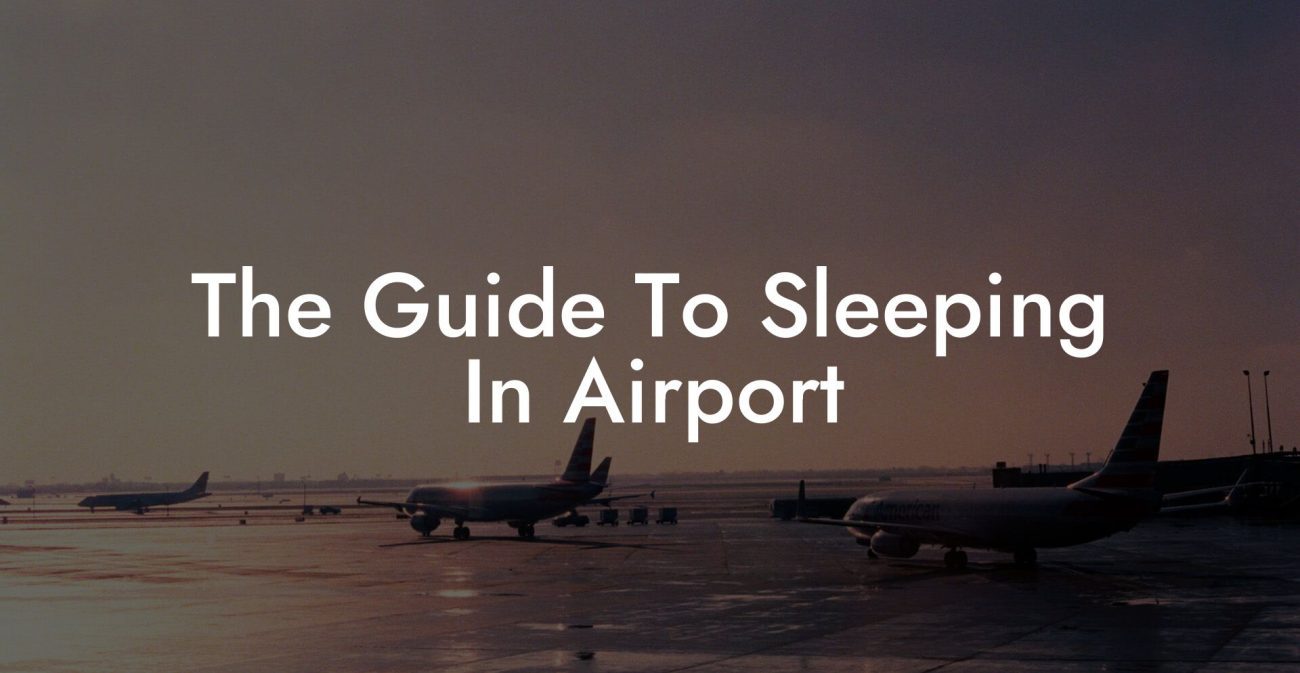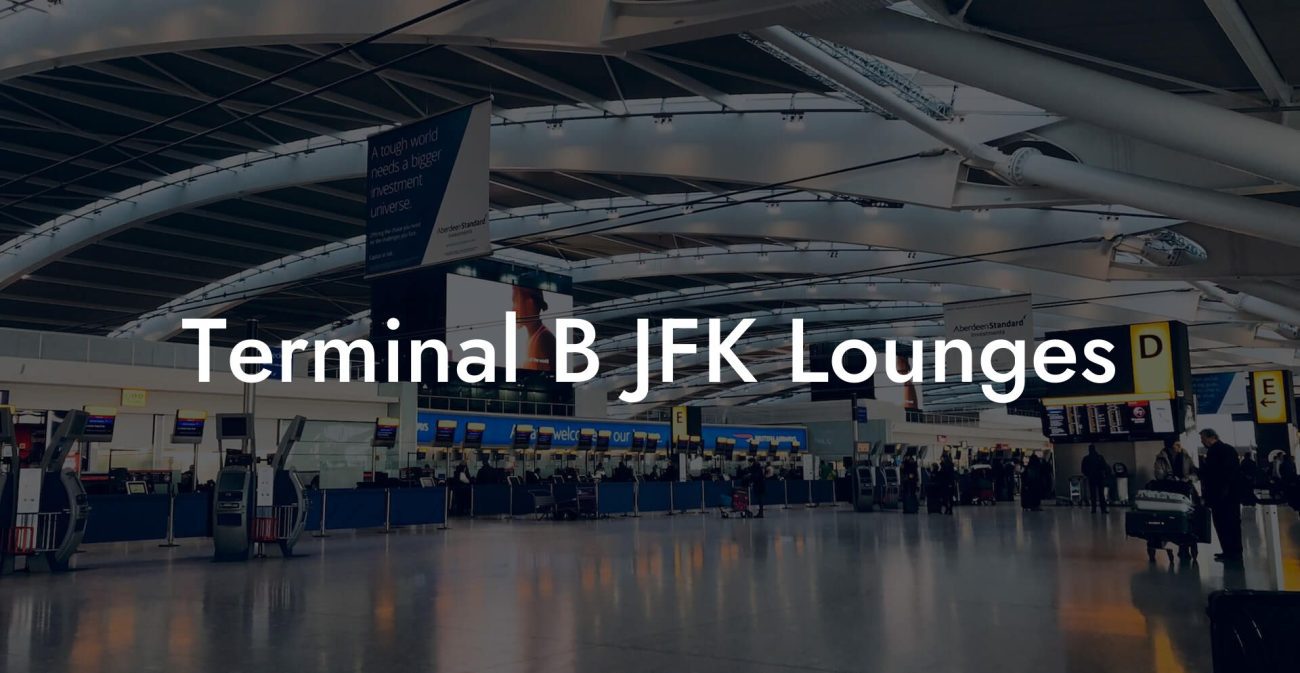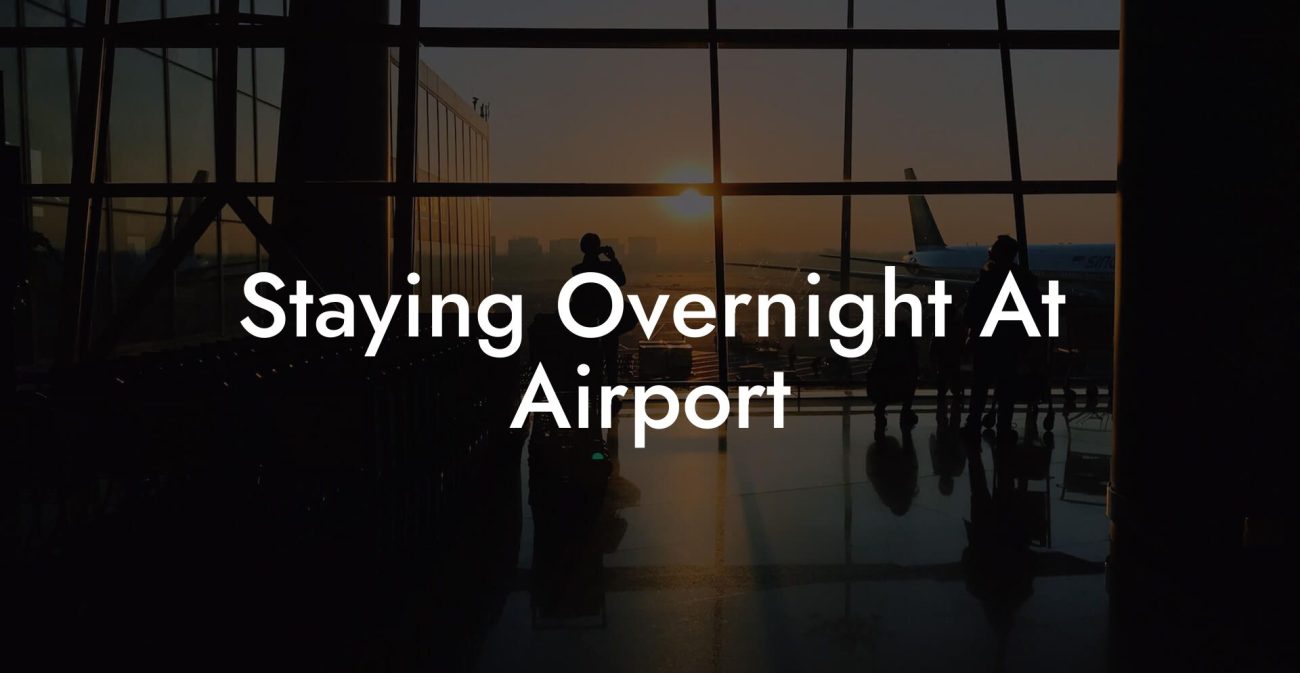Ever wondered why your airplane seat never transforms into a cozy bunk bed despite all the wild ideas about maximizing travel sleep? Let’s dive into the wacky world of airplane design, where physics, safety regulations, and a dash of practicality collide to answer the ultimate travel riddle: Why don’t planes have bunk beds?
Quick Links to Useful Sections
- The High-Flying Bunk Bed Dilemma
- Space Constraints: When Every Inch Counts
- The Safety Gauntlet: Regulations and Real-World Testing
- Emergency Evacuation Protocols
- Turbulence and Stability
- Crashworthiness and Impact Resistance
- Aerodynamics and Weight: The Science Behind the Sky
- The Weighty Issue
- Aerodynamic Drag and Cabin Design
- Passenger Comfort versus Practicality: The Ultimate Trade-Off
- Optimizing Seat Configurations
- The Economics of Comfort
- The History of In-Flight Sleep Solutions: From Hammocks to Pods
- The Hammock Experiment
- Lie-Flat Seats and Sleep Pods
- Technological Innovations and the Future of Air Travel Sleep
- Modular Cabins and Adaptive Interiors
- Wearable tech and Sleep Optimization
- Sleep Strategies for the Modern Traveler: Airport Sleep Pods and Beyond
- Finding the Perfect Airport Sleep Pod
- Maximizing Sleep in Less-Than-Ideal Environments
- The Balancing Act: Comfort, Economics, and the Environmental Edge
- Cultural Influences: How Sleep Trends Shape Air Travel
- Designing the Perfect In-Flight Experience: Beyond Bunk Beds
- Resources and Community Support: Your Next Steps
- FAQs on Airplane Bunk Beds and In-Flight Sleep Innovations
- Embracing a New Paradigm in Air Travel Sleep
The High-Flying Bunk Bed Dilemma
Picture this: you’ve just wrapped up a red-eye flight and your body craves the comfort of a real bed, not just an upright seat with a backrest that grudgingly reclines a few inches. The idea of bunk beds on planes—one layered above the other—might seem like the perfect sleep hack for Gen-Z wanderers and millennials who value every minute of shut-eye. But before you start sketching your dream airplane interior, there are some major reasons why these cushy multi-tiered marvels haven’t graced the cabin.
In today’s travel landscape, short on sleep and possibly stuck in an airport lounge for hours, the concept of bunk beds sparks the imagination. However, the challenges to create a safe, efficient, and comfortable sleeping environment at 35,000 feet are as complex as the inner workings of aviation technology itself.
From strict safety regulations to the unforgiving laws of aerodynamics and weight distribution, airplane interiors are a masterclass in design compromise. So, let’s unpack the factors that keep airplane cabins strictly seat-based and why even the most innovative ideas like bunk beds have yet to take flight.
Space Constraints: When Every Inch Counts
Airplanes are meticulously engineered machines where every inch of space is optimized for efficiency. Unlike hotels or even high-speed trains that can afford a little extra room for luxury, aircraft must contend with a strict spatial economy. Here’s why:
- Aerodynamic Efficiency: The shape and weight of the cabin directly impact fuel efficiency and flight stability. Adding extra structures like bunk beds could disrupt the carefully calculated weight distribution and aerodynamics that keep the plane flying smoothly.
- Cabin Layout Priorities: Modern aircraft are designed with a focus on maximizing passenger density and ensuring easy evacuation in the event of an emergency. Bunk beds would complicate this layout, potentially curtailing access and delaying emergency exits.
- Structural Integrity: The fuselage—the main body of the airplane—must be both strong and lightweight. Reinforcing it to support bunk beds, including the extra weight and motion of occupants moving about, would require significant, and expensive, modifications to the aircraft’s design.
While the idea of a bunk bed may conjure images of efficient use of vertical space (think of a teen’s cramped bedroom reimagined for the skies), the reality is a lot more challenging when every square inch is already engineered to perfection.
The Safety Gauntlet: Regulations and Real-World Testing
Safety is the cornerstone of aviation, and no design change can be implemented without exhaustive testing and regulatory approval. When you’re thousands of feet above the ground, a few extra inches of structure could mean the difference between life and death in a critical situation. Consider these safety concerns:
Emergency Evacuation Protocols
In the fast-paced chaos of an emergency, every second counts. Airplanes are required to provide clear, unobstructed pathways to exits. Bunk beds, with their inherent vertical stacking, would not only consume additional space but could also obstruct passageways, complicating evacuation procedures during a crisis.
Turbulence and Stability
Imagine a flight experiencing unexpected turbulence while you’re tucked away in the top bunk. The unpredictable jolts could transform a restful nap into a precarious ordeal. Airplanes are designed to manage the movement of seated passengers, but sleeping in elevated, unsecured bunks introduces new risks and makes it difficult for seat belts to offer full protection.
Crashworthiness and Impact Resistance
Every component in an airplane cabin is meticulously tested for its ability to withstand high-energy impacts. Bunk beds would have to meet the same stringent standards as the seats, from securing passengers during a crash to preventing injuries from flying objects. This means rethinking materials, anchoring mechanisms, and overall design robustness.
The rigorous safety testing in aviation is no joke. Regulatory bodies like the FAA (Federal Aviation Administration) and EASA (European Union Aviation Safety Agency) ensure that every modification to an aircraft is not only innovative but also supremely safe. In this landscape, the risks of deploying a new sleeping configuration have so far outweighed the potential benefits.
Aerodynamics and Weight: The Science Behind the Sky
At the heart of modern airplane design lies the unyielding reality of physics. Aircraft are designed to be as light and aerodynamic as possible—a principle that is crucial for both performance and fuel efficiency.
The Weighty Issue
Additional furniture like bunk beds would add unnecessary weight to the aircraft, a factor that airlines are always keen to minimize. Every extra kilogram demands more fuel, directly affecting cost efficiency and environmental impact. Given that airlines operate on razor-thin margins, any additional weight requires a critical cost-benefit analysis.
Moreover, the weight of the cabin components must be evenly distributed to maintain the delicate balance required for smooth takeoffs, flights, and landings. Integrating bunk beds without disrupting this balance represents a significant engineering conundrum.
Aerodynamic Drag and Cabin Design
The external shape of an aircraft is carefully crafted to reduce drag and improve fuel efficiency. While most cabin modifications are internal and don’t directly affect the plane’s aerodynamic profile, the internal weight and structure still play a crucial role. Any modifications that compromise the streamlined nature of the airplane can lead to increased fuel consumption—which is a non-starter for budget-conscious airlines.
In essence, while bunk beds might offer a novel twist on in-flight sleeping, the science of flight demands that every extra structure is justified by a significant benefit in comfort, efficiency, or safety. So far, this balance hasn’t tipped in favor of installing bunk beds.
Passenger Comfort versus Practicality: The Ultimate Trade-Off
The notion of transforming cramped airline seating into a snug, layered bed might appeal directly to the travel dreams of millennials and Gen Z, who are always on the hunt for innovative sleep solutions. However, the truth is that airplane designers have historically prioritized practicality over plush comfort.
Optimizing Seat Configurations
Modern planes come equipped with various seating configurations designed to maximize efficiency. Premium cabins offer lie-flat seats, and some long-haul flights now feature innovative sleep pods that emulate a bed-like experience while ensuring safety and cost-effectiveness. While these sleep solutions may not be full bunk beds, they represent a compromise between functionality and comfort.
Additionally, airlines are increasingly exploring modular interior designs that allow for a spectrum of seating options based on flight duration, airline brand, and passenger demographics. However, the transformation from seats to beds in a multi-tiered stacked arrangement remains a complex puzzle.
The Economics of Comfort
Let’s be real—airline seats are designed to be as economical as possible. Installing bunk beds could potentially elevate ticket prices, making air travel less accessible to budget-minded travelers. For many, the appeal of flying lies in its affordability, and any added cost for seats that convert into beds would likely be met with resistance.
Furthermore, considering the maintenance costs, boarding procedures, and the additional cleaning and safety checks required, the overall economics of a bunk bed configuration become less appealing to airlines already juggling slim profit margins.
The History of In-Flight Sleep Solutions: From Hammocks to Pods
It’s worth noting that the desire for better sleep in the sky isn’t a modern phenomenon. Throughout aviation history, innovators have experimented with a range of creative solutions to help passengers catch some quality Z’s.
The Hammock Experiment
In the early days of commercial flight, some airlines toyed with the idea of installing hanging beds or hammocks to offer a semblance of comfort on long-haul journeys. However, these early experiments were short-lived. The challenges ranged from ensuring that the hammocks could be securely fastened to dealing with the constant movement of the aircraft—a recipe for discomfort rather than rest.
Lie-Flat Seats and Sleep Pods
Fast forward a few decades, and airlines began to pivot towards lie-flat seats in business and first-class cabins. These seats, which can be adjusted into a near-horizontal position, represented a sophisticated solution that balanced comfort with safety. More recently, some airlines have introduced dedicated sleep pods or mini suites, particularly on ultra-long-haul flights, where passengers can enjoy a more private, bed-like experience.
While these innovations mark significant improvements over traditional cramped seating, the concept of stacked bedding—bunk beds—has largely remained on the drawing board. The evolution of in-flight sleep solutions continues to reflect a careful dance between engineering feasibility and passenger demand.
Technological Innovations and the Future of Air Travel Sleep
The future of air travel is brimming with possibilities, and technological advances are constantly pushing the envelope when it comes to passenger comfort. While bunk beds may still be a distant dream, emerging technologies are paving the way for other revolutionary sleep solutions in the air.
Modular Cabins and Adaptive Interiors
Engineers and designers are exploring modular cabin concepts that allow airlines to reconfigure the interior of an aircraft based on the flight’s duration, passenger demographics, and even seasonal demand. Imagine a plane that can shift from a standard layout during the day to a sleep-centric configuration by night, seamlessly transforming seats into rest zones complete with adjustable lighting and ambient soundscapes.
Although bunk beds aren’t on the immediate agenda, these adaptive interiors represent the spirit of innovation—pushing the boundaries of in-flight comfort while still adhering to the uncompromising safety and efficiency standards of modern aviation.
Wearable tech and Sleep Optimization
In an age where wearable technology tracks everything from heart rate to sleep cycles, it’s only natural that similar innovations could influence air travel. Future aircraft may incorporate smart seats that adapt in real-time to a passenger’s physiology, promoting better posture and optimizing for sleep quality.
As airlines look to the horizon, the integration of sleep-enhancing technologies—ranging from noise-canceling systems to personalized climate control—will likely be prioritized over radical seating overhauls that jeopardize safety and efficiency. These advancements underscore a holistic approach to improving in-flight sleep without resorting to the logistical nightmare that bunk beds would bring.
Sleep Strategies for the Modern Traveler: Airport Sleep Pods and Beyond
While airplanes may not offer bunk beds, the quest for a good night’s sleep during travel has not been abandoned. For those long transits, airports around the globe are stepping up their game with innovative sleep solutions, such as airport sleep pods, quiet zones, and even dedicated napping lounges.
Finding the Perfect Airport Sleep Pod
Airport sleep pods are the latest trend in travel wellness. These compact, futuristic rest areas allow weary travelers to catch a few z’s in a secure, private nook. With ergonomic designs, ambient lighting, and smart climate control, these sleeping capsules are perfect for recharging between flights.
When scouting for an airport with sleep pods, keep a lookout for airlines and terminals embracing modern travel amenities. They’re often featured in travel guides and online reviews, making it easier for tech-savvy Gen Z and millennial globetrotters to plan their layovers accordingly.
Maximizing Sleep in Less-Than-Ideal Environments
Not every airport has state-of-the-art sleep pods, so developing a strategy for quality rest in unconventional spaces is key. Consider these tips:
- Earplugs and Eye Masks: These simple travel accessories can create a personal oasis of darkness and silence—even in the busiest terminals.
- Travel Pillows and Blankets: Invest in a comfortable neck pillow and a lightweight blanket to make your seat as cozy as possible.
- Find a Quiet Corner: Many airports offer designated quiet rooms or less trafficked gates where you can settle down away from the crowd.
- Leverage Apps: Use travel apps that monitor sleep-friendly zones within the airport and even offer guided meditations to help you relax.
Even when the flight itself doesn’t offer much in terms of actual bed space, these airport amenities allow you to optimize your travel sleep strategy, ensuring that you arrive at your destination refreshed and ready to conquer the day.
The Balancing Act: Comfort, Economics, and the Environmental Edge
At its core, the design of an airplane is a balancing act between comfort, cost, and environmental responsibility. Airlines are under constant pressure to reduce fuel consumption and minimize their carbon footprint, and every design decision plays into this larger narrative.
Introducing bunk beds into the mix would significantly raise questions about energy efficiency and operational costs. The extra hardware, maintenance, and potential redesign of emergency systems would translate into higher ticket prices—a move many airlines and passengers would likely balk at.
Moreover, in an era where sustainability is paramount, the focus is on creating aircraft that are not only comfortable but also eco-friendly. Innovations tend to gravitate towards lighter materials, improved aerodynamics, and advances in propulsion technology rather than radical cabin reconfigurations that might hinder these efforts.
In other words, while the charm of a bunk bed is undeniable, the modern aircraft design ethos favors incremental improvements that balance passenger comfort with environmental and economic realities.
Cultural Influences: How Sleep Trends Shape Air Travel
It’s no secret that travel trends are influenced by the ever-evolving priorities of the global community. As Gen Z and millennials continue to champion the need for better mental and physical health, customer demands are gradually reshaping the in-flight experience.
Despite the charm of bunk beds, cultural shifts have instead spurred a surge in demand for smart, flexible sleep solutions. Airlines are listening, and many are now piloting luxurious business class seats that recline into beds, creating private sanctuaries in the sky. These innovations reflect a trend where comfort is tailored to individual needs without compromising the strict safety and design protocols of conventional aircraft.
Furthermore, travel influencers routinely share tips on how to optimize sleep on flights—ranging from the best earplugs to the clever use of travel pillows—as part of a broader dialogue on wellness and productivity. This grassroots dialogue has shifted the focus from radical cabin redesigns to smart modifications that can realistically enhance travel comfort.
Designing the Perfect In-Flight Experience: Beyond Bunk Beds
Let’s face it: while the fantasy of bunk beds in the skies remains alive in our daydreams, the future of airplane comfort is being forged by creativity and technology. Modern air travel offers a buffet of innovative solutions—each crafted to enhance the overall experience without compromising safety or efficiency.
Designers and engineers are continuously experimenting with adjustable mood lighting, personalized climate zones, and even noise-cancellation systems integrated within the seat structure. These initiatives not only optimize your journey by transforming discomfort into something more tolerable—but they also pave the way for the next generation of travel innovations.
So, while you’re more likely to find a seat that reclines into a flatbed than a stacked bunk bed, know that the quest for comfort is far from over. As air travel evolves, the potential for even more creative sleep solutions continues to grow, promising a future where your journey is as rejuvenating as your destination.
Resources and Community Support: Your Next Steps
For those who can’t help but fantasize about more comfortable sleep options—whether you’re catching a red-eye or contemplating an airport layover—there are plenty of resources and communities out there to support your journey to better rest.
Check out travel blogs, YouTube channels, and social media groups dedicated to travel hacks and sleep optimization. Join forums where fellow globetrotters swap tips on airport sleep pods, the best travel pillows on the market, and how to optimize that tiny airplane seat to feel just a bit more like a bunk bed.
There are also mobile apps that track airport amenities and real-time flight comfort updates to help you plan your journey more effectively. Getting involved in these communities not only keeps you informed but also supports a larger movement toward improved travel comfort and innovative in-flight designs.
Remember, your travel experience is not just about the destination—it’s about ensuring you arrive rested and ready to take on the day. Embrace these resources and join a community that prioritizes comfort, creativity, and the shared pursuit of making air travel a little more humane.
FAQs on Airplane Bunk Beds and In-Flight Sleep Innovations
Here are some frequently asked questions that break down the complexities of in-flight sleeping solutions and why bunk beds remain a dream rather than a reality.
1. Why don’t airplanes have bunk beds?
Airplanes are designed with strict space, weight, and safety limitations. Bunk beds would complicate emergency evacuations, disrupt weight distribution, and create aerodynamic inefficiencies, making them impractical and potentially unsafe.
2. Could bunk beds be introduced on future aircraft?
While it’s an imaginative idea, significant advances in engineering, safety protocols, and cost management would be required before bunk beds could become a viable option in commercial aviation.
3. What other in-flight sleep solutions exist?
Modern airlines offer a range of sleep-friendly solutions, from lie-flat business class seats and premium economy options to innovative sleep pods in some airports that help travelers catch a quick nap between flights.
4. How do airport sleep pods work?
Airport sleep pods are compact, secure cabins designed to provide privacy and comfort for short naps. They often feature adjustable lighting, soundproofing, and climate control, making them a popular option among weary travelers.
5. What are some travel tips for better sleep on airplanes?
Pack quality earplugs, an eye mask, a comfortable travel pillow, and perhaps even a lightweight blanket. Choose a quiet zone or a favorable seat location, and consider using apps that track sleep-friendly features in airports.
6. Are in-flight sleep innovations environmentally friendly?
Yes, modern aircraft innovations aim to enhance passenger comfort while minimizing additional weight and promoting fuel efficiency—a key factor in reducing an airline’s environmental impact.
These frequently asked questions reflect the multifaceted challenges airlines face when balancing comfort with safety, cost, and sustainability.
Embracing a New Paradigm in Air Travel Sleep
The debate over why airplanes don’t sport bunk beds may never lead to the vertical sleep wonder we imagine, but it shines a spotlight on the remarkable ingenuity behind modern air travel. The relentless pursuit of safety, efficiency, and comfort has led designers to carve out innovative solutions that are tailored to today’s needs—like premium lie-flat seats, smart cabin lighting, and airport sleep pods that are redefining rest on the go.
While the dream of sprawling bunk beds in the skies might still exist in our imaginative daydreams, the practical reality is a blend of engineering brilliance and thoughtful innovation. Airlines are continually tweaking their interiors to offer just a bit more comfort without compromising on safety or efficiency. It’s a delicate dance of balancing cutting-edge technology with time-tested design principles.
So next time you’re buckled into your seat on a long flight, remember: though you might not be stacking your bed with the latest in bedding trends, you’re part of an age-old tradition of travel that celebrates pragmatism, creativity, and the relentless drive to improve every journey. Whether it’s through a later upgrade to business class or a strategic airport nap in a sleek sleep pod, there’s plenty of innovation on the horizon to make your travels as restful as possible.
Embrace the future of air travel sleep, join the conversation online with fellow travel enthusiasts, and keep an eye out for the next wave of technological breakthroughs that might one day bring those wild ideas—like airplane bunk beds—a little closer to reality. Until then, safe travels, and may every flight be as comfortable as possible!
Useful Interruption: Dive deeper into the world of airport sleeping guides with our most popular sections. If there is anything you think is missing or anything you would love for us to write about, just give us a shout.
- General Airport Sleeping Guides
- Travel Gear & Equipment Recommendations
- Regional and Airport-Specific Guides
- Airport Sleeping Pods & Reviews
- Health, Safety, and Comfort Tips for Airport Sleepers
Last week, I decided to try the world-famous "airport sleepover" experience. Imagine this: I'm lying on a bench in Terminal C, surrounded by suitcases that have seen more of the world than I ever will, and a PA system that sounds like a karaoke machine on a sugar rush. I pull out my travel pillow—which, by the way, is more like a sad deflated balloon—and declare, "Tonight, I’m the king of this terminal!"
Soon enough, fellow travelers become my unexpected audience. One guy, fresh off a red-eye, whispers, "Hey, do you think if we sleep long enough, we can catch our flight in our dreams?" I reply, "Sure, and maybe I'll even get an upgrade to first-class in my nap!" The airport lights flicker like a disco ball, and every time someone announces a delayed departure, it’s like a punchline to our impromptu stand-up routine.
As I finally drift off, I dream of a world where boarding passes are like VIP tickets to the best sleepover party ever—a party where the only baggage is the laughter you carry with you. Waking up, I realize the airport is still the same, but I now hold the honorary title of "Terminal Comedian," a title I wear with as much pride as my permanently mismatched socks!

